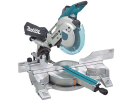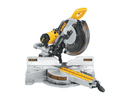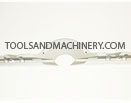How to Align a Miter Saw Fence
 It comes as no shock that our miter saws can take quite a beating in the shop, on the job, and while trudging from jobsite to jobsite. In fact, it can be pretty simple to take these super-tools, these seemingly indestructible sawing giants for granted. When it all comes down to it though, our miter saws, albeit awesome, are a bit more delicate than all that. Just like you or me, they can loose their balance or get thrown out of whack; these kinks though, require just a bit of operator tenderness to work out.
It comes as no shock that our miter saws can take quite a beating in the shop, on the job, and while trudging from jobsite to jobsite. In fact, it can be pretty simple to take these super-tools, these seemingly indestructible sawing giants for granted. When it all comes down to it though, our miter saws, albeit awesome, are a bit more delicate than all that. Just like you or me, they can loose their balance or get thrown out of whack; these kinks though, require just a bit of operator tenderness to work out.
You see, the leading cause of inaccurate cuts when using a miter saw (save for perhaps some good old fashioned operator error) is actually a misaligned or bowed fence. In other words, after a series of good jobsite wallopings, there’s a good chance you’ve kicked your fence out of perfect alignment. Because misalignment of the rip fence can cause dangerous kickback and of course those sloppy cuts and inaccurate angles, this alignment thing is pretty important – and this alignment process, despite seeming a bit rudimentary, is a particularly important one as well. Be precise and be cautious.
To begin, you’ll need a framing square or straight-edge that is at least as long as your fence, and a small piece of ultra thin paper (i.e. tracing paper, telephone book paper, or something of a like thickness). With the framing square (or straight-edge) press the paper against the fence and pull at the top of the paper. At all points from one end of the fence to the other, the paper should be tightly stuck between the fence and the square. If at any point you can remove the paper from said contraption, you have a bow in the fence that needs to be corrected.
 To adjust a one-piece fence (right), loosen the screws closest to the bow and, remembering to not over-correct, use a pry bar to force the imperfection straight by applying a concentrated pressure against, and in the opposite direction, of the bow. Maintain
To adjust a one-piece fence (right), loosen the screws closest to the bow and, remembering to not over-correct, use a pry bar to force the imperfection straight by applying a concentrated pressure against, and in the opposite direction, of the bow. Maintain
 pressure on the pry bar and loosely tighten the screws. Test again to ensure the sway has sufficiently straightened. Repeat the process until the paper can not be removed from any point on the fence. Additionally, and as with almost all things in life, this procedure is generally easier with four hands; if someone can help you, gratefully accept their offer and hold and push and pull and test and measure until your fence is perfectly straight. Also, and again, please be cautious as you work, be aware of your pressure at all times and move in very tiny increments to ensure you don’t over-correct any given bowing point. After you have checked and re-checked the straightness of your fence, ensure all screws are tightly secured.
pressure on the pry bar and loosely tighten the screws. Test again to ensure the sway has sufficiently straightened. Repeat the process until the paper can not be removed from any point on the fence. Additionally, and as with almost all things in life, this procedure is generally easier with four hands; if someone can help you, gratefully accept their offer and hold and push and pull and test and measure until your fence is perfectly straight. Also, and again, please be cautious as you work, be aware of your pressure at all times and move in very tiny increments to ensure you don’t over-correct any given bowing point. After you have checked and re-checked the straightness of your fence, ensure all screws are tightly secured.
To adjust a two-piece fence
, you’ll again loosen the screw closest to the imperfection in your fence and apply pressure via gently prying or tapping the fence against the bowing point (towards the framing square or straight-edge). When the two sides of the fence align, release pressure and tighten (but do not securely tighten) the screw. Test the length of the fence once more and continue to tap and pry the fence until you are perfectly straight. After alignment is achieved, tightly secure all screws.













